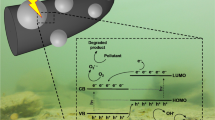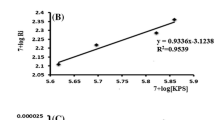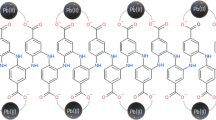Abstract
In this work, the electrochemical oxidation of arsenite and its subsequent removal was studied using water-soluble poly[glycidyl methacrylate N-methyl-d-glucamine], P(GMA–NMG), and poly[2-(acryloyloxy)ethyl]trimethylammonium chloride, P(ClAETA). In the first stage, the electroanalysis of arsenic (via oxidation of arsenite to arsenate) by cyclic voltammetry in the presence of water-soluble polymers was conducted. The type of polymer, electrode (gold or platinum), polymer concentration, and pH were evaluated. The study indicated that using P(GMA–NMG) and a gold electrode, oxidation peaks were obtained at approximately +0.5 V versus Ag/AgCl. In the case of P(ClAETA), wide oxidation peaks were obtained at +0.8 V versus Ag/AgCl using a platinum electrode. The optimum concentration for both polymers was 0.05 mol L−1. For P(GMA–NMG), the oxidation potential was influenced by a change of pH. The quantitative oxidation of As(III) to As(V) was conducted using metallic electrodes with higher surface areas. The conversion of arsenic as a function of applied potential was also evaluated. The results showed an efficient oxidation in the presence of both water-soluble polymers. Finally, 60 % of the As(V) could be removed through polymer-enhanced ultrafiltration. The results demonstrated an increase in the removal of pre-oxidized arsenic.







Similar content being viewed by others
References
Cullen RW, Reimer K (1989) Arsenic speciation in the environment. Chem Rev 89:713–764
Fergusson JF, Gavis J (1972) A review of the arsenic cycle in nature waters. Water Res 6:1259–1274
Welch AH, Westjohn DB, Helsel DR, Wanty RB (2000) Arsenic in ground water of the United States: occurrence and geochemistry. Groundwater 38:589–604
Smedley PL, Kinniburgh DG (2002) A review of the source, behaviour and distribution of arsenic in natural waters. Appl Geochem 17:517–568
Mandal BK, Suzuki KT (2002) Arsenic round the world: a review. Talanta 58:201–235
Hung DQ, Nekrassova O, Compton RG (2004) Analytical methods for inorganic arsenic in water: a review. Talanta 64:269–277
Feeney R, Kounaves SP (2002) Voltammetric measurement of arsenic in natural waters. Talanta 58:23–31
Cavicchioli A, La-Scalea MA, Gutz IGR (2004) Analysis and speciation of traces of arsenic in environmental, food and industrial samples by voltammetry: a review. Electroanalysis 16:697–711
Gamboa JCM, Cornejo L, Squella JA (2014) Vibrating screen printed electrode of gold nanoparticle-modified carbon nanotubes for the determination of arsenic(III). J Appl Electrochem. doi:10.1007/s10800-014-0727-6
Dai X, Nekrassova O, Hyde ME, Compton RG (2004) Anodic stripping voltammetry of arsenic(III) using gold nanoparticle-modified electrodes. Anal Chem 76:5924–5929
Majid E, Hrapovic S, Liu Y, Male KB, Luong JHT (2006) Electrochemical determination of arsenite using a gold nanoparticle modified glassy carbon electrode and flow analysis. Anal Chem 78:762–769
Dai X, Compton RG (2006) Detection of As(III) via oxidation to As(V) using platinum nanoparticle modified glassy carbon electrodes: arsenic detection without interference from copper. Analyst 131:516–521
Dai X, Compton RG (2005) Gold nanoparticle modified electrodes show a reduced interference by Cu(II) in the detection of As(III) using anodic stripping voltammetry. Electroanalysis 17:1325–1330
Litter MI, Morgada ME, Bundschuh J (2010) Possible treatments for arsenic removal in Latin American waters for human consumption. Environ Pollut 158:1105–1118
Sánchez J, Rivas BL (2010) Arsenic extraction from aqueous solution: electrochemical oxidation combined with ultrafiltration membranes and water-soluble polymers. Chem Eng J 165:625–632
Leupin OX, Hug SJ (2005) Oxidation and removal of arsenic(III) from aerated groundwater by filtration through sand and zero-valent iron. Water Res 39:1729–1740
Rivas BL, Aguirre MC, Pereira E, Bucher C, Royal G, Limosin D, Saint-Aman E, Moutet J-C (2009) Off-line coupled electrocatalytic oxidation and liquid phase polymer based retention (EO-LPR) techniques to remove arsenic from aqueous solutions. Water Res 43:515–521
Sánchez J, Rivas BL, Pooley SA, Basaez L, Pereira E, Pignot-Paintrand I, Royal G, Saint-Aman E, Bucher C, Moutet J-C (2010) Electrocatalytic oxidation of As(III) to As(V) using noble metal–polymer nanocomposites. Electrochim Acta 55:4876–4882
Rivas BL, Aguirre MC, Pereira E, Bucher C, Moutet J-C, Saint-Aman E, Royal G (2011) Efficient polymers in conjunction with membranes to remove As(V) generated in situ by electrocatalytic oxidation. Polym Adv Technol 22:414–419
Rivas BL, Pereira ED, Palencia M, Sánchez J (2011) Water-soluble functional polymers in conjunction with membranes to remove pollutant ions from aqueous solutions. Prog Polym Sci 36:294–322
Moreno-Villoslada I, Rivas BL (2002) Competition of divalent metal ions with monovalent metal ions on the adsorption on water-soluble polymers. J Phys Chem B 106:9708–9711
Rivas BL, Pooley SA, Luna M (2000) Chelating properties of poly(N-acryloyl piperazine) by liquid-phase polymer-based retention (LPR) technique. Macromol Rapid Commun 21:905–908
Rivas BL, Pereira ED, Cid R, Geckeler K (2005) Polyelectrolyte-assisted removal of metal ions with ultrafiltration. J Appl Polym Sci 95:1091–1099
Rivas BL, Moreno-Villoslada I (2000) Effect of the polymer concentration on the interactions of water-soluble polymers with metal ions. Chem Lett 2:166–167
Rivas BL, Moreno-Villoslada I (2000) Poly[acrylamide-co-1-(2-hydroxyethyl) aziridine]: an efficient water-soluble polymer for selective separation of metal ions. J Appl Polym Sci 69:817–824
Toledo L, Rivas BL, Urbano BF, Sánchez J (2013) Novel N-methyl-D-glucamine-based water-soluble polymer and its potential application in the removal of arsenic. Sep Purif Technol 103:1–7
Sánchez J, Rivas BL, Nazar E, Bryjak M, Kabay N (2013) Boron removal by liquid-phase polymer-based retention technique using poly(glycidyl methacrylate N-methyl D-glucamine). J Appl Polym Sci 162:1541–1545
Ottakam Thotiyl MM, Basit H, Sánchez J, Goyer C, Coche-Guerente L, Dumy P, Sampath S, Labbé P, Moutet J-C (2012) Multilayer assemblies of polyelectrolyte–gold nanoparticles for the electrocatalytic oxidation and detection of arsenic(III). J Colloid Interface Sci 383:130–139
Rivera JF, Bucher C, Saint-Aman E, Rivas BL, Aguirre MC, Sanchez J, Pignot-Paintrand I, Moutet JC (2013) Removal of arsenite by coupled electrocatalytic oxidation at polymer–ruthenium oxide nanocomposite and polymer-assisted liquid phase retention. Appl Catal B 129:130–136
Acknowledgments
The authors thank the FONDECYT (Project No. 1110079), FONDECYT (postdoctoral Grant No. 3120048), DIUC (211.021.030-1.0), PIA (Anillo ACT-130), REDOC (MINEDUC project UCO1202 at U. de Concepción), and CIPA, Chile.
Author information
Authors and Affiliations
Corresponding author
Rights and permissions
About this article
Cite this article
Sánchez, J., Butter, B., Rivas, B.L. et al. Electrochemical oxidation and removal of arsenic using water-soluble polymers. J Appl Electrochem 45, 151–159 (2015). https://doi.org/10.1007/s10800-014-0785-9
Received:
Accepted:
Published:
Issue Date:
DOI: https://doi.org/10.1007/s10800-014-0785-9




